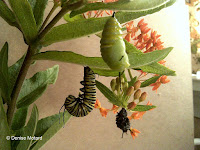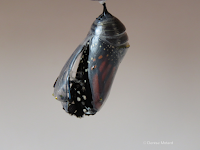CHRYSALIS
This page shows photos and videos taken of Monarch chrysalises raised inside. There are some stages to a chrysalis, from the moment it starts moving inside the ‘J’ phase caterpillar to detach itself from it from the inside, to the last stage where it turns black and orange and we can see the butterfly inside, ready to emerge.
(More general information on the Monarch butterfly can be found here.)
PREPARING TO TURN INTO A CHRYSALIS
The ‘J’ phase of a Monarch caterpillar doesn’t last long, about 10-12 hours depending on the temperature. When the time to pupate comes, the caterpillar undergoes some changes. If you want to watch the chrysalis come out of the caterpillar, you need to keep an eye on the tentacle changes and the body movements.
Tentacles: When close to turning into a chrysalis, the tentacles (which are NOT antennae, but still are sensing organs) at both ends of the caterpillar will become limp and twisted, emptied of their fluids (photo to the right, below).
 |
 |
Body Movements: the caterpillar periodically bends its upper body closer to the rest, and relaxes it somewhat. This is accompanied by repeated head ‘noddings’. You can tell that there’s something going on inside.
Then as the time to turn into a chrysalis gets closer, general body contractions will start in waves, pushing the caterpillar skin up and stretching the lower part behind the head. This is where the skin eventually splits lengthwise and the chrysalis gradually bulges out.
The first video shows a caterpillar in the ‘J’ phase about one hour prior to pupating into a chrysalis:
This video below is of the same caterpillar around 30 minutes before pupating. Note that the general waving movements have started, where the chrysalis inside detaches itself from its caterpillar skin:
TURNING INTO A CHRYSALIS
Most of the time the fresh chrysalis, with all its pushing and twisting into the silk pad, will be able to completely detach its empty caterpillar skin, which then falls to the ground. Below are two exceptions, but they had no impact on the butterflies that emerged from those chrysalises.
 |
 |
 |
 |
 |
 |
Below are videos of caterpillars turning into a chrysalis, shown in real time. There comes a point where, as the chrysalis comes out, it doesn’t hold onto much. This happens just before it attaches its own cremaster hook to the silk pad, when the caterpillar skin is pushed up and still attached to the silk pad by its last pair of prolegs.
What the chrysalis needs to do at that point is pull out its own black cremaster hook from under the old caterpillar skin, and send it up until it reaches the silk pad.
As soon as the chrysalis hook makes contact with the silk pad, we can see an acceleration in the body movements of the chrysalis – it twists right and left trying to push its cremaster hook as deep as it can into the silk pad.
At the same time it needs to detach the prolegs of its old caterpillar skin from the same silk pad, and push that skin off. This is a crucial time for the chrysalis, and as soon as it reaches that point, it stops the frantic twisting and jerking, and will only repeat some of those movements mildly in the ensuing couple minutes, just to make sure the hook is secure.
This video below gives a better view of the black cremaster hook. The tip of this hook is made of dozens of tiny hooks that the chrysalis pushes into the silk pad. The result is something very solid, a velcro-like fastening.
THE REGULAR CHRYSALIS
Why call this section ‘regular‘ chrysalis? If you look at the fresh chrysalis photos and videos above, and compare with the photos below of chrysalises a few days old, you will notice a number of differences. The changes actually take place not long after the chrysalis emerges.
Color: the new chrysalis still shows some yellow and white barring from its time as a caterpillar, but after a few hours the color becomes a uniform light green and it turns more opaque. The chrysalis green color also changes as the butterfly forms inside.
Shape: the fresh chrysalis is about half abdominal rings with the lower part showing the future butterfly head, antennae and wings. After a few hours though, the shape is smooth and almost a uniform cylinder.
Golden dots collar: The typical golden and black dots ‘collar’ that is near the top of the regular chrysalis is around the middle when the chrysalis has just come out, and it has more white than golden.
Male or female? Please go to this page for how to find the sex of a Monarch chrysalis
 |
 |
 |
DARKENING CHRYSALIS
The time a Monarch chrysalis takes to emerge as a butterfly varies according to the temperature – the warmer the shorter the period. This period can vary from 9 to 14 days approximately. During that time, the chrysalis undergoes some visible changes in its color, getting increasingly darker.
At the same time, the chrysalis envelope gets thinner and transparent, so that we can actually see the butterfly forming – the orange and black wings, the black body with its white spots, and the abdominal segments at the top.
Generally these noticeable changes occur in the last 48 hours of the chrysalis stage. But of course, the butterfly development inside is a continuous process, it’s just that we don’t see most of it.
I had a caterpillar that turned into a chrysalis in a lilac outside. After surviving a bad storm (see photo above) I brought it inside (the three photos below) without wiping it. It kept its little rain drops till the end! Note the change in color between the first photo and the third one. For more photos when this chrysalis turns into a butterfly, please visit this page.
 |
 |
 |
There is a visible difference between the two photos below of the same chrysalis, 1 hour 53 minutes apart. The top part above the golden dot ‘necklace’ is smooth at 8:49 am (left), but on the right photo (10:42 am) we can now clearly see the abdominal segments through the chrysalis envelope.
 |
 |
BUTTERFLY GETTING DETACHED FROM THE INSIDE
Another indication that the Monarch butterfly is going to emerge soon is when it gets detached from the chrysalis envelope. The butterfly from the chrysalis below emerged as a female about 30 minutes following the last photo.
 |
 |
 |
THE INVERTED ‘V’
The photos below show the inverted ‘V’ pattern on the chrysalis. When the butterfly emerges, the thin and dry chrysalis envelope tears up along those ‘V’ lines, starting at the bottom.
 |
 |
 |